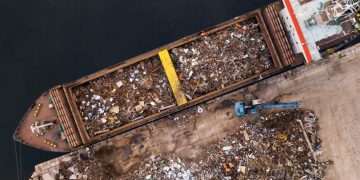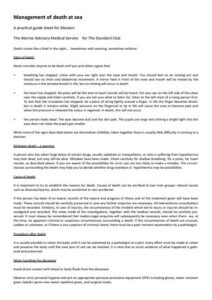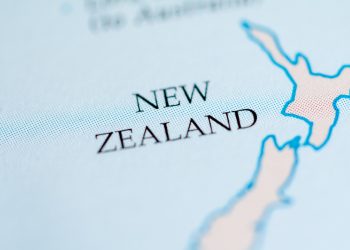The Marine Advisory Medical Service for Standard Club has provided a practical guide for Masters regarding the management of death at sea.
Signs of death
Never consider anyone to be dead until you and others agree that:
- Breathing has stopped. Listen with your ear right over the nose and mouth. You should feel no air coming out and should see no chest and abdominal movement. A mirror held in front of the nose and mouth will be misted by the moisture in the exhaled breath in life, but no misting will occur in death.
- The heart has stopped. No pulse will be felt and no heart sounds will be heard. Put your ear on the left side of the chest near the nipple and listen carefully. If you are not sure what to listen for, listen to the left chest of a living person first. To test that the circulation has stopped, tie a piece of string tightly around a finger. In life the finger becomes bluish, but in death it remains white. Slight pressure on the fingernail or lip in life will cause the area to become pale and when the pressure is released the colour is regained. In death, this will not occur.
- The person looks dead. The eyes become dull and the skin pale. The pupils are large and shining a bright light into the eyes does not make the pupils get smaller.
Mistaken death
A person who has taken large doses of certain drugs, usually sedatives or tranquillisers, or who is suffering from hypothermia may look dead, but may still be alive. Mistakes have been made. Check carefully for shallow breathing, for a pulse, for heart sounds, as described above. If you are aware of the possibilities for error you are less likely to make a mistake. The circumstances surrounding the death may help you to decide whether drug overdose or hypothermia may be possibilities.
Cause of death
It is important to try to establish the reasons for death. Causes of death can be ascribed to two main groups: natural causes such as illnesses/injuries, which may be accidental or non-accidental.
If the person has been ill on board, records of the nature and progress of illness and of the treatment given will have been made. These records should be carefully preserved in case any further enquiries are necessary. All telemedicine consultations must be recorded.
Similarly, in case of injuries, the circumstances of the incident which led to injury or injuries should be investigated and recorded. The notes made of the investigations, together with the medical records, should be carefully preserved. It must always be remembered that medico-legal enquiries will subsequently be necessary even when there are, at the time, no apparent criminal or suspicious circumstances surrounding a death.
If the circumstances of death are unusual, sudden or unknown, or if there is any suspicion of criminal intent, there must be a post-mortem examination by a pathologist.
Procedure after death
It is usually possible to retain the body until it can be examined by a pathologist at a port. Every effort must be made to retain and preserve the body until the next port of call can be reached. It is vital that as much evidence of what happened is gathered and preserved.
When handling the deceased
- Avoid direct contact with blood or body fluids from the deceased.
- Observe strict personal hygiene and put on appropriate personal protective equipment (PPE) including gloves, water resistant gown /plastic apron over water repellent gown, and surgical masks.
- Use goggles or face shield to protect eyes if there may be splashes from bodily fluids.
- Make sure any wounds are covered with waterproof bandages or dressings.
- Remove personal protective equipment after handling of the deceased.
- Wash hands with liquid soap and water immediately.
Body removal
- The deceased can be wrapped with a bed sheet/linen.
- In ideal circumstances the deceased should be placed in a robust and leak-proof transparent plastic bag of not less than 150 cm thick, which should be zippered closed.
- Deceased which is found soiled with blood or body fluids should be placed in a disposable plastic bag instead of linen.
- A secondary opaque body bag to be used should, robust and have carry handles to ensure safe removal to refrigeration.
- Attach an appropriate identity label to the body bag before transport to temporary ‘on-board mortuary’.
Body storage
- They should be in a suitable and secure place to safeguard the security of the deceased.
- The deceased should be stored in cold chambers (ship refrigerator if necessary, but not freezer) maintained at approximately +4°C. Given the importance of the temperature setting this should be supervised by an engineer, and if necessary the cook if a catering fridge is used.
- Never allow the body to be stored at temperatures below +2°C.
- Stored off the floor of the cold chamber if possible, with Identity label visible outside body bag.
































































